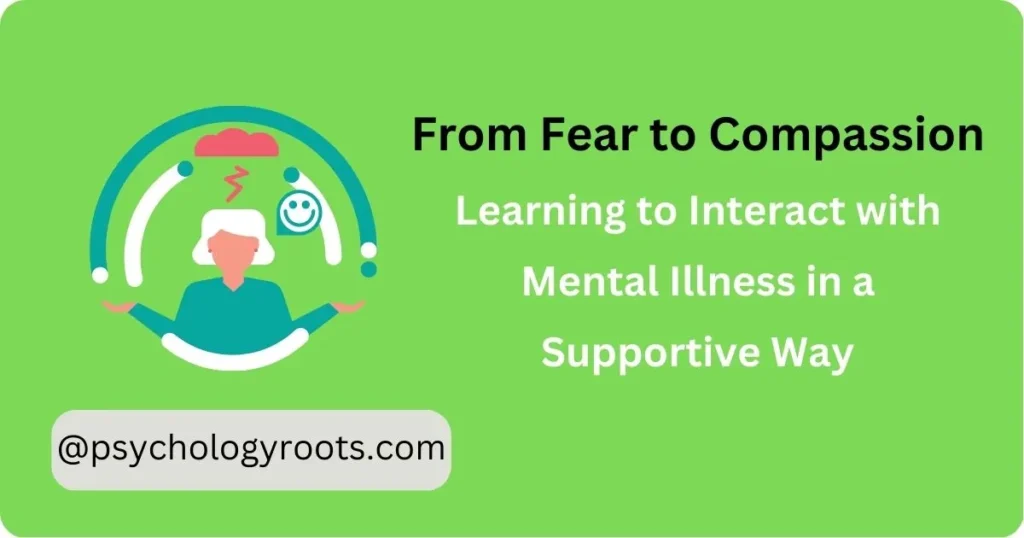Table of Contents
From Fear to Compassion: Learning to Interact with Mental Illness in a Supportive Way
Here in this post, we are discussing “From Fear to Compassion: Learning to Interact with Mental Illness in a Supportive Way”. You can read more about psychology-related material on our website. Keep visiting Psychology Roots.
Mental illness affects millions of people around the world, yet it is still surrounded by stigma and misunderstanding. One of the consequences of this stigma is that interactions with mentally ill individuals can be fraught with fear, judgment, and negative assumptions. However, by learning to interact with mentally ill individuals in a supportive and compassionate way, we can reduce this stigma and help to create a more inclusive and understanding society. In this blog post, we will explore how fear can impact interactions with mentally ill individuals, the importance of empathy in reducing stigma, and strategies for interacting with mentally ill individuals in a supportive way. By the end of this post, readers will have a better understanding of how to move from fear to compassion in their interactions with mentally ill individuals.

Understanding mental illness
Mental illness refers to a wide range of conditions that affect a person’s thoughts, emotions, and behavior. These conditions can include depression, anxiety, bipolar disorder, schizophrenia, and many others. Mental illness is not uncommon – in fact, according to the World Health Organization, one in four people worldwide will experience a mental illness at some point in their lives. Despite this, mental illness is often shrouded in stigma and misunderstanding. Many people may assume that mental illness is a sign of weakness or a character flaw, or that mentally ill individuals are dangerous or unpredictable. These misconceptions can contribute to fear and discomfort when interacting with mentally ill individuals.
The impact of fear on interactions with mentally ill individuals
When we approach interactions with mentally ill individuals from a place of fear, it can lead to negative outcomes. Fear can cause us to make assumptions about the person’s behavior or intentions, leading to unfair judgments or even discrimination. Fear can also make us feel uncomfortable or uncertain about how to act, leading to awkward or unproductive interactions. Moreover, fear can perpetuate stigma by reinforcing negative stereotypes about mental illness.
The role of empathy in interacting with mentally ill individuals
One way to move past fear and toward compassion in interactions with mentally ill individuals is to cultivate empathy. Empathy involves putting oneself in another person’s shoes and trying to understand their perspective and emotions. When we approach mentally ill individuals with empathy, we are more likely to recognize and validate their experiences, rather than making assumptions or judgments. This can lead to more productive and positive interactions, as well as reduced fear and stigma.
Strategies for interacting with mentally ill individuals in a supportive way
Here are some strategies that can help you interact with mentally ill individuals in a supportive way:
- Practice active listening and validation. This means paying attention to what the person is saying, reflecting back what you hear, and acknowledging their feelings and experiences.
- Avoid making assumptions or judgments about the person based on their mental illness. Instead, focus on getting to know them as an individual.
- Offer support and resources. This could include suggesting therapy or counseling, connecting the person with mental health resources in the community, or simply offering a listening ear.
- Remember that mentally ill individuals are people first and foremost. They have hobbies, interests, and relationships just like anyone else, and should be treated with respect and dignity.
Conclusion
By moving from fear to compassion in our interactions with mentally ill individuals, we can help to reduce stigma and create a more inclusive and understanding society. This requires understanding mental illness, recognizing the impact of fear on interactions, and cultivating empathy and supportive strategies. With these tools in hand, we can all work to create a world where mental illness is understood, accepted, and supported.
Help Us Improve This Article
Have you discovered an inaccuracy? We put out great effort to give accurate and scientifically trustworthy information to our readers. Please notify us if you discover any typographical or grammatical errors.
Make a comment. We acknowledge and appreciate your efforts.
If you have any scale or any material related to psychology kindly share it with us at psychologyroots@gmail.com. We help others on behalf of you.